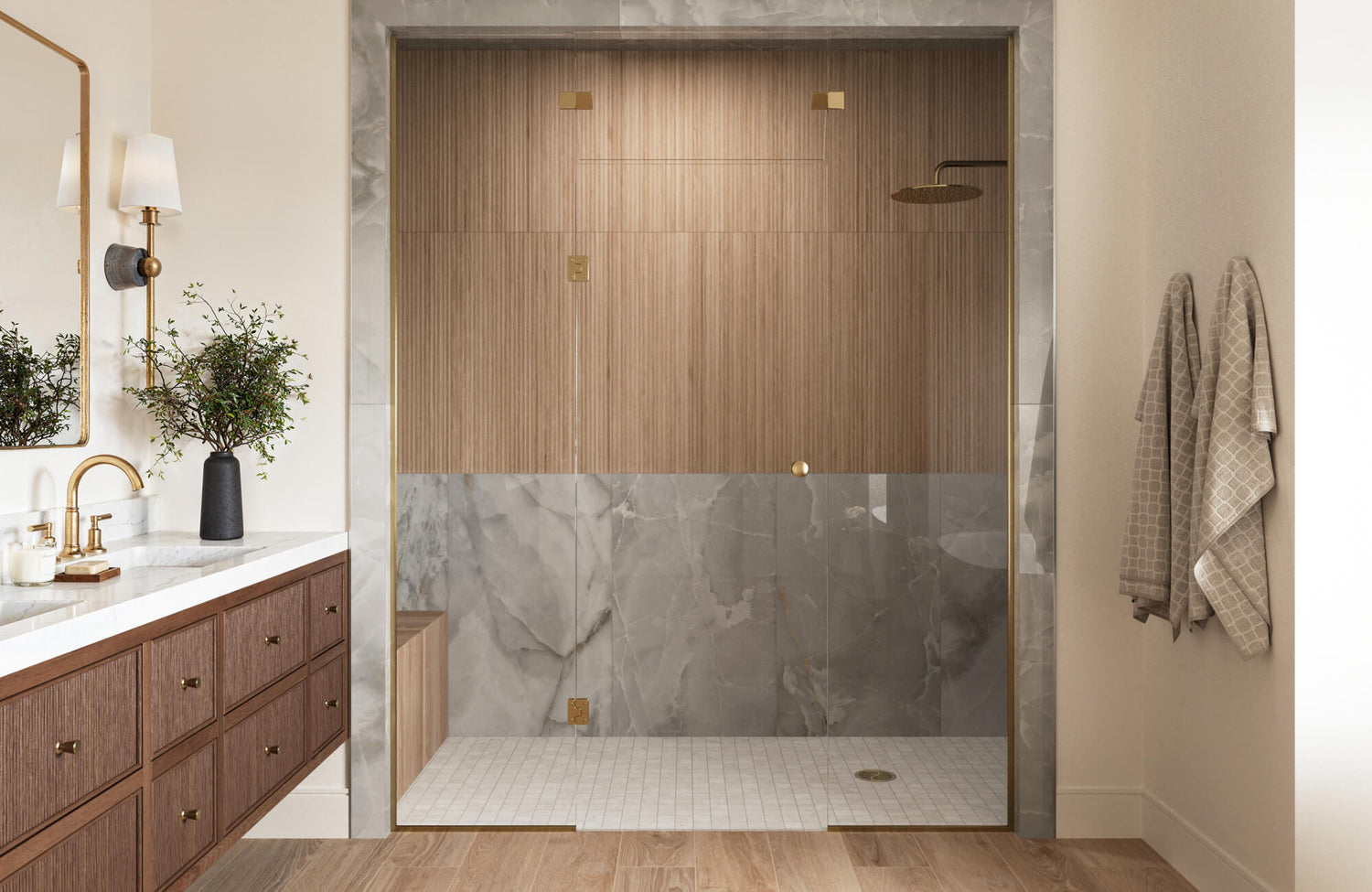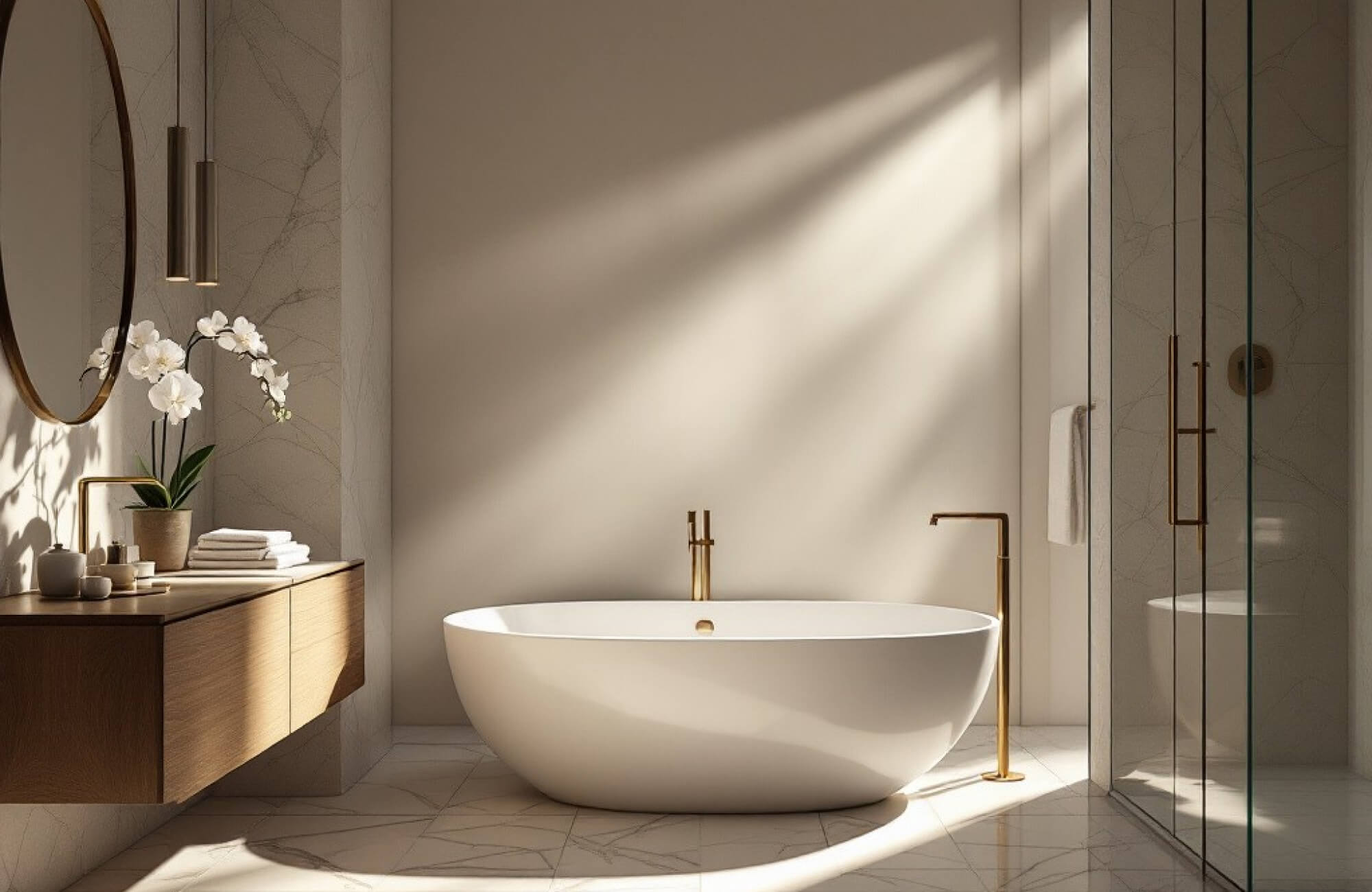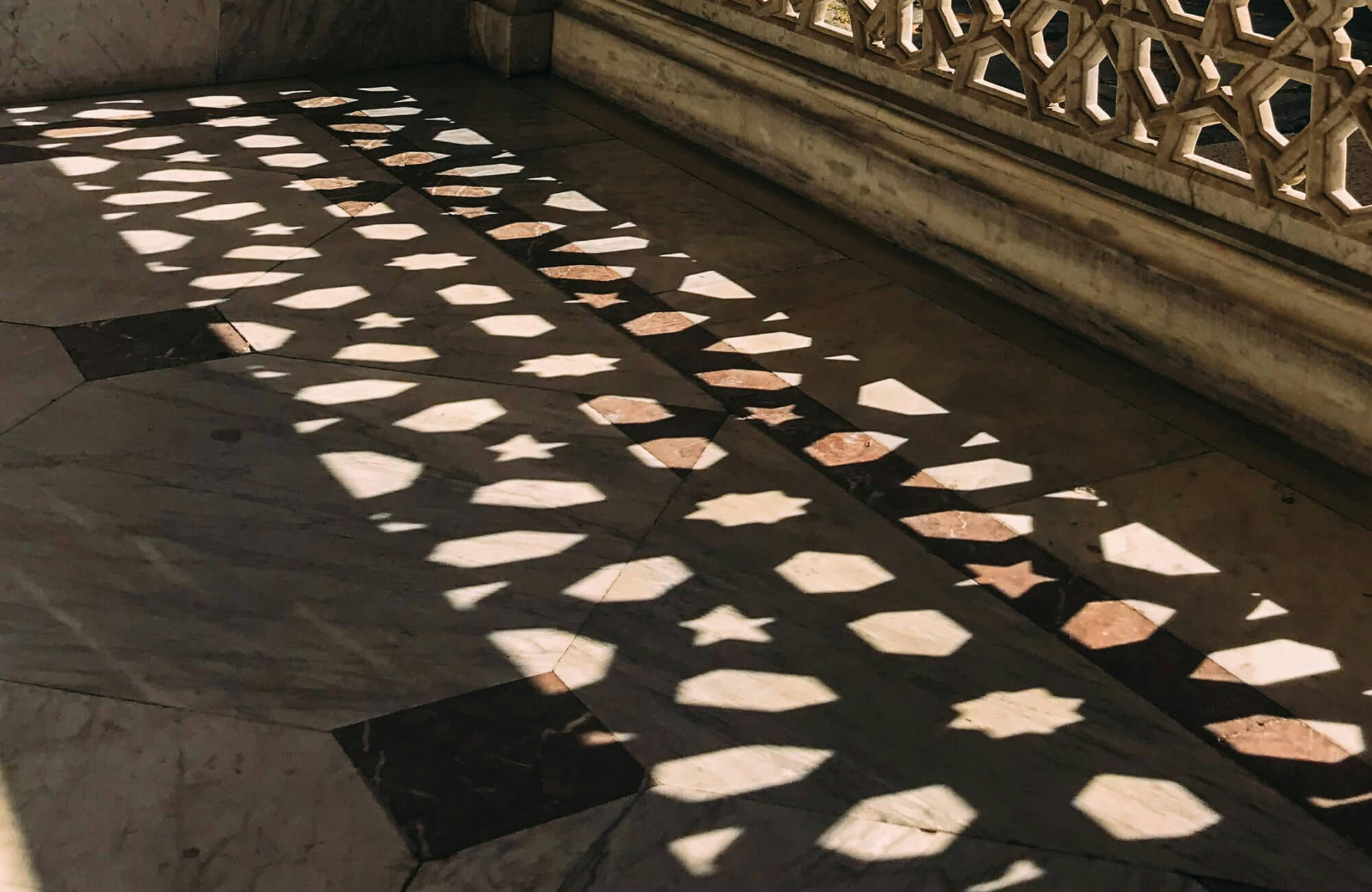Bathroom tiles are more than just functional coverings; they are the unsung heroes of interior design, capable of transforming a mundane space into a luxurious retreat. The right tile choice can elevate your bathroom's aesthetic appeal, enhance its functionality, and significantly impact your overall home decor. From classic to contemporary, minimalist to maximalist, the possibilities are endless. In this guide, we'll examine the key factors to consider when selecting the perfect bathroom tiles, ensuring a space that's both stylish and practical.
Understanding Your Bathroom Style
The first step in selecting the perfect bathroom tile is to define your desired aesthetic. Your bathroom style will dictate the type of tile, color palette, and pattern that best complements your overall design vision. Here are a few popular bathroom styles to inspire you:
Minimalist Modern
Embrace simplicity and sophistication with a minimalist modern bathroom. Clean lines, neutral color palettes, and large format tiles are the hallmarks of this style. Consider using large porcelain slabs for a sleek, monolithic look, or opt for subway tiles for a timeless, classic feel. Terrazzo tiles, with their speckled appearance, can also add a touch of organic texture to your minimalist space.
Classic Elegance
For a timeless and luxurious bathroom, consider a classic elegant style. Ornate patterns, rich colors, and high-quality materials with luxurious appearance like marble and granite are key elements of this look. Also consider intricate mosaic patterns or detailed tile borders to add a touch of opulence.
Rustic Charm
Bring the beauty of nature indoors with a rustic-inspired bathroom. Warm, earthy tones, and natural materials like stone, wood, and terracotta are essential to this style. Consider using reclaimed wood for vanity tops or wall accents, or opt for stone tiles with a honed or tumbled finish for a weathered look.
Contemporary Chic
Embrace bold colors, geometric patterns, and mixed materials for a contemporary chic bathroom. Mosaic tiles, porcelain or ceramic tiles, and metallic accents can add a touch of glamour and sophistication. You can also experiment with different shapes, sizes, and textures to create a visually stunning space.
Considering Tile Material
The choice of tile material significantly impacts the durability, aesthetics, and maintenance requirements of your bathroom. Let's explore some of the most popular tile materials:
Ceramic Tiles
Ceramic tiles are a classic choice for bathrooms due to their versatility, affordability, and durability. They are available in a wide range of colors, patterns, and finishes, making them suitable for various design styles. While ceramic tiles are generally durable, it's important to consider their water absorption rate, especially for areas with high moisture, such as shower walls. Glazed ceramic tiles are more water-resistant than unglazed tiles, making them an ideal choice for these areas.
Porcelain Tiles
Porcelain tiles are a premium option known for their exceptional durability, water resistance, and stain resistance. They are denser and less porous than ceramic tiles, making them ideal for busy areas like floors and outdoor spaces. Porcelain tiles are also available in various styles, from traditional to contemporary, and can accurately mimic the look of natural materials like stone, wood, and marble.
Natural Stone Tiles
Natural stone tiles, such as marble, granite, and limestone, exude timeless elegance and luxury. They offer unique veining patterns and textures that add character to any bathroom. However, natural stone tiles require careful maintenance and regular sealing, as they are susceptible to staining and etching. It's also important to note that they can be more expensive than ceramic or porcelain tiles, but their beauty and durability often justify the investment.

Selecting the Right Tile Size and Shape
The size and shape of your tiles can significantly impact the overall look and feel of your bathroom. Consider these factors when making your selection:
Large Format Tiles
Large format tiles, typically measuring 12 inches or larger, create a minimalist and spacious look. They are ideal for modern and contemporary bathrooms, as they minimize grout lines and create a clean, streamlined aesthetic. However, it's important to ensure that your surfaces are perfectly flat and plumb to accommodate these large tiles.
Small Format Tiles
Small format tiles, such as subway tiles, are larger than mosaics but still compact, often rectangular or square in shape. They add texture and depth to a space while complementing traditional, modern, or eclectic styles. These tiles are also well-suited for creating clean, structured patterns like herringbone or bricklaying and can be used to define accent walls or borders. While less intricate than mosaics, they offer a classic aesthetic with a timeless appeal.
Mosaic Tiles
Mosaic tiles consist of small, intricate pieces arranged to form patterns or designs, typically mounted on mesh sheets for easy installation. They are highly customizable and versatile, making them ideal for creating unique visual effects on backsplashes, accent walls, and even shower floors for extra traction. Available in materials like porcelain, ceramic, glass, and stone, mosaic tiles often emphasize detail and intricacy. Choosing the right grout color is especially important, as it impacts the overall design and pattern visibility.
Choosing the Right Tile Color and Pattern
The color and pattern of your tiles can significantly impact the mood and atmosphere of your bathroom. Consider these color schemes and patterns to create a space that reflects your personal style:
Neutral Colors
Neutral shades like white, gray, beige, and brown, are timeless and versatile. They create a clean, minimalist aesthetic and can make your bathroom feel larger and brighter. A stunning example of this is the Sarina 3x12 Glossy Ceramic Fishscale Tile in Cloud shown in the photo above, which combines a soft, white tone with a unique fishscale pattern for added elegance and charm.
Tiles in these colors also provide the perfect canvas for creative design. They can act as a subtle backdrop to highlight bold patterns, vibrant accent colors, or decorative features, allowing you to effortlessly adapt your bathroom’s style over time.
Monochromatic Palette
A monochromatic color scheme, featuring various shades of a single color, creates a calm and serene atmosphere. This cohesive, minimalist approach not only promotes a sense of harmony but can also make the space appear larger and more open. To prevent the design from feeling flat, you can incorporate different textures and finishes, such as matte and glossy tiles. This subtle variation adds depth and visual interest while maintaining the elegance of a unified color palette.
Complementary and Analogous Colors
For a vibrant and high-contrast look, complementary colors like blue and orange or red and green create bold, energetic designs. To avoid overwhelming the space, balance these colors with neutral tones like white, black, or gray. Conversely, analogous colors, such as blues paired with greens or oranges with yellows, offer a harmonious and tranquil feel. This approach is perfect for creating a soothing and cohesive bathroom atmosphere.
Bold Patterns
Bold patterns are an excellent way to infuse personality and drama into your bathroom design. Patterns like herringbone, chevron, basketweave, and hexagonal arrangements can transform walls or floors into stunning focal points. For example, a herringbone pattern using elongated subway tiles creates dynamic movement, while a chevron design offers a sharp, angular aesthetic that feels modern and stylish. Basketweave patterns, on the other hand, provide a classic, woven look ideal for accent walls.
When working with bold patterns, it’s essential to balance them with solid colors to maintain harmony in the space. For instance, the Olivia 4x16 Glossy Ceramic Tile in Cotto can serve as a striking accent when paired with neutral tones on surrounding walls. If you’re hesitant about fully committing to bold patterns, start small by incorporating them into a backsplash, niche, or border, and gradually expand as you gain confidence in your design choices.
Or if you're still unsure about the right tile color, pattern, or layout for your bathroom, take advantage of Edward Martin's Augmented Reality (AR) tool. This innovative feature allows you to visualize various tile options in your space, helping you make confident decisions about your design.

Practical Considerations
Beyond aesthetics, it's crucial to consider practical factors when selecting bathroom tiles. These factors will impact the longevity, safety, and ease of maintenance of your bathroom:
Water Absorption
Water absorption is a critical factor to consider, especially for tiles used in wet areas like showers and floors. Tiles with low water absorption are more resistant to water damage, mold, and mildew. As previously highlighted, porcelain tiles are highly water-resistant, making them an excellent choice for these areas.
Ceramic tiles, on the other hand, can also be water-resistant, but their water absorption rate can vary depending on the type of glaze and firing process. Due to their slightly higher absorption rates compared to porcelain, ceramic tiles are more commonly used on walls, where exposure to standing water is less frequent.
Slip Resistance
Safety is a critical consideration in any bathroom, making slip-resistant tiles an essential choice to prevent accidents. A tile’s slip resistance is measured by its coefficient of friction (COF)—the higher the COF rating, the greater the slip resistance. Textured tiles, such as those with a matte finish, raised patterns, or slightly rough surfaces, provide better traction compared to smooth, glossy tiles.
For optimal safety, use slip-resistant tiles in areas prone to water exposure, such as shower floors and around bathtubs. Mosaic tiles crafted from porcelain are an excellent option for these areas, as their small size and multiple grout lines enhance grip.
Maintenance
The ease of cleaning and maintenance of your bathroom tiles will significantly impact your daily routine. Glazed ceramic or porcelain tiles are among the easiest to clean, as their smooth, non-porous surface prevents dirt and grime from penetrating. Routine cleaning with a mild detergent and water is typically sufficient to keep them spotless, though periodic attention is needed to prevent soap scum and hard water stains.
In contrast, natural stone tiles like marble or travertine, while undeniably stunning, require more care due to their porous nature. They are prone to staining, etching, and moisture absorption, making regular maintenance essential. Applying a high-quality sealer periodically can protect the stone and preserve its appearance.
Budget
Budget is a crucial factor in choosing bathroom tiles, and understanding the cost variations between materials can help you make informed decisions. Ceramic tiles are typically the most budget-friendly option, offering a wide range of styles and colors without a hefty price tag. Porcelain tiles, while more expensive, provide greater durability and resistance to water, making them a worthwhile investment for busy or moisture-prone areas. Natural stone tiles, such as marble or travertine, are at the higher end of the price spectrum, valued for their luxurious appearance but requiring additional maintenance.
When planning your budget, it’s essential to weigh upfront costs against long-term value. While premium materials like porcelain may have a higher initial expense, their durability and timeless appeal can result in cost savings over time by reducing the need for repairs, replacements, or constant maintenance. Striking the right balance between your budget, desired aesthetic, and practical functionality ensures a choice that meets both your financial and design goals.
Conclusion
Choosing the right bathroom tiles is a crucial decision that can significantly impact the overall look and feel of your space. Thoughtfully evaluating factors such as material, size, color, pattern, and practical needs can help you achieve a design that aligns with your vision. To ensure the best results, consult with design professionals who can provide expert advice tailored to your specific requirements and preferences. Their insights can guide you in navigating the endless possibilities, from minimalist aesthetics to bold, statement-making designs.
You can also experiment with combinations of tiles to create a unique and personalized look that reflects your personality and enhances your bathroom's ambiance. Whether your goal is to craft a serene retreat or a vibrant, stylish space, the right tiles can transform your bathroom into a luxurious and functional oasis. By leveraging professional expertise and thoughtful planning, you can bring your dream bathroom to life with confidence.










